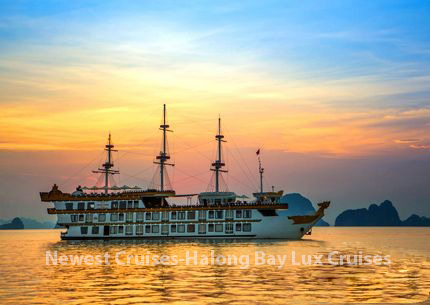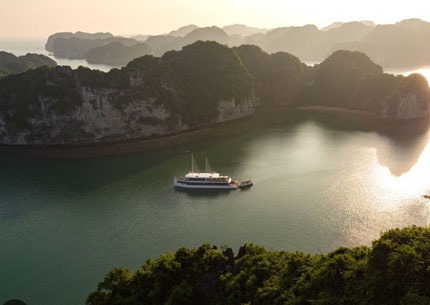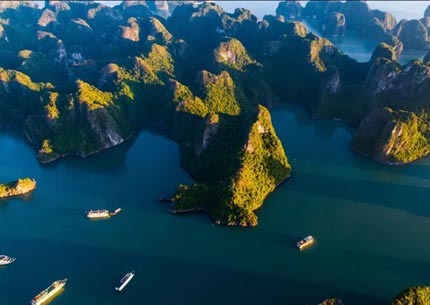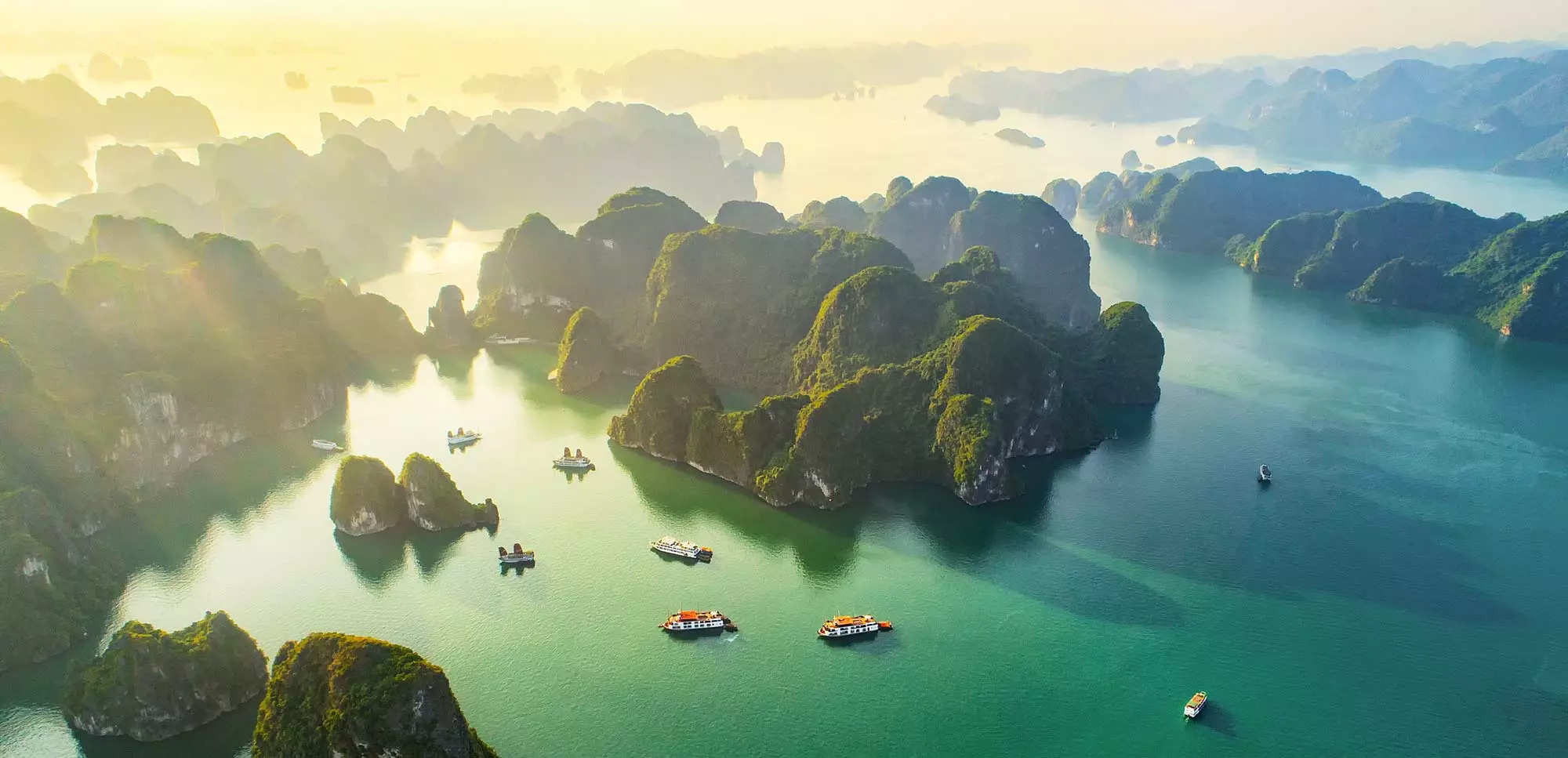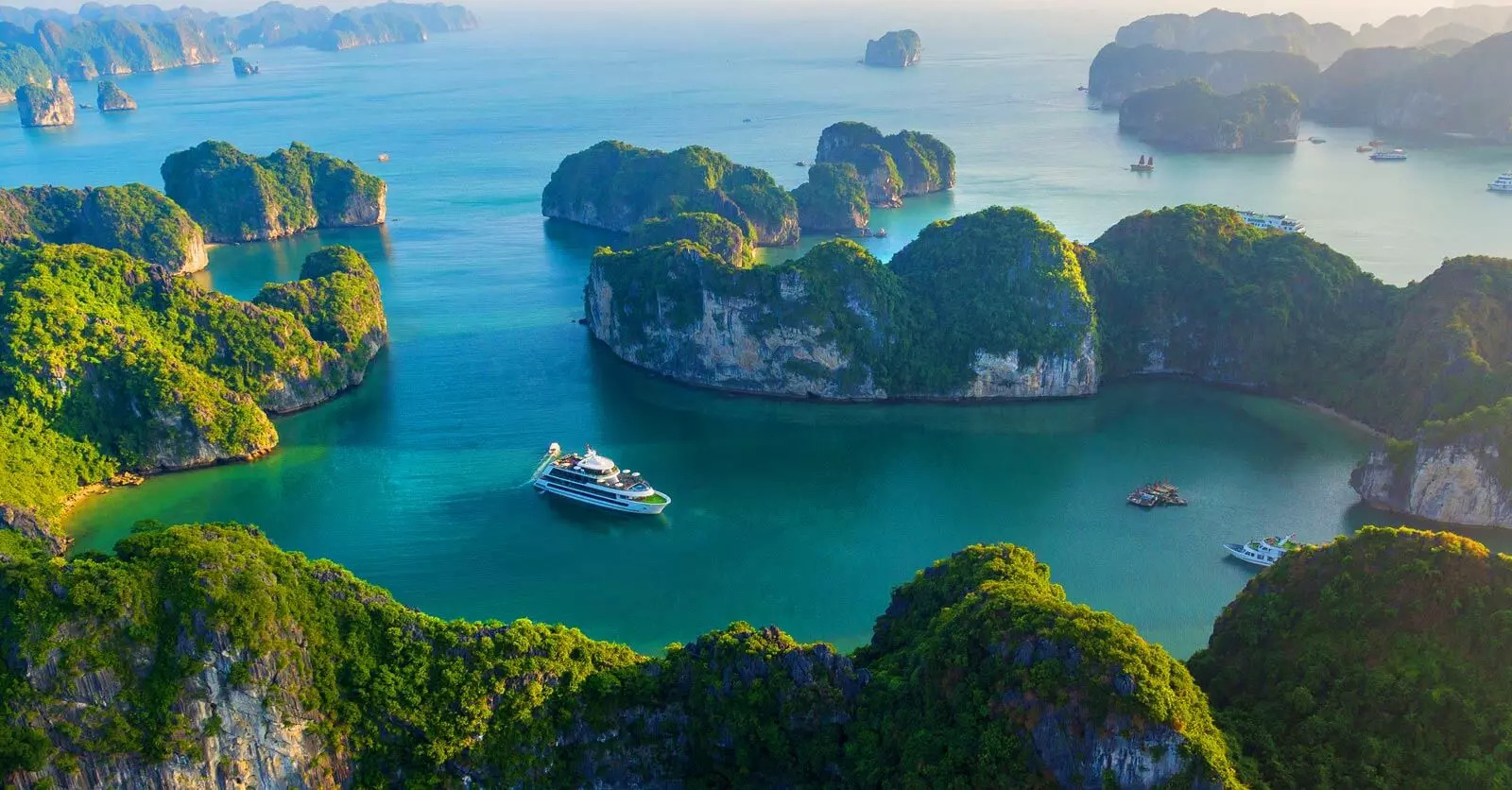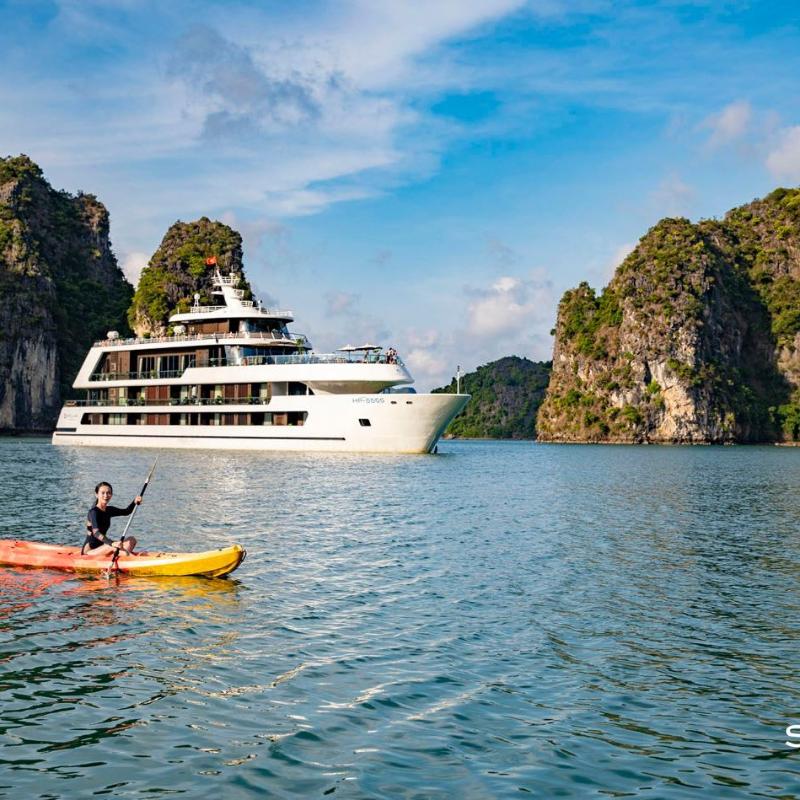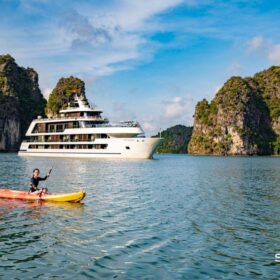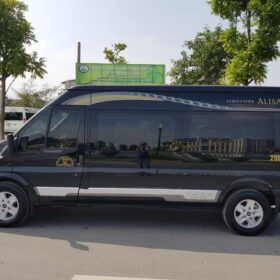15 Essential Halong Bay Safety Tips for Worry-Free Cruising in 2025-2027
Navigating the emerald waters of Vietnam’s most iconic seascape requires more than just booking a ticket. As Halong Bay welcomes over 7 million visitors annually, understanding crucial safety measures ensures your journey remains memorable for all the right reasons. This comprehensive guide delivers expert-verified safety protocols tailored for travelers planning adventures through 2027.

Safety Preparations Before Your Halong Bay Cruise
Selecting a Certified Cruise Operator with Proven Safety Records
The foundation of a secure Halong Bay experience begins with choosing the right cruise company. Vietnam’s Maritime Administration has implemented stringent regulations for 2025-2027, requiring all operators to maintain specific safety standards.
When booking, verify these essential credentials:
- Valid operating license from the Quang Ninh Provincial Authority
- Maritime safety certification with renewal dates clearly displayed
- Insurance documentation covering passengers and activities
- Transparent safety record with no major incidents in the past 3 years
- Professionally trained crew with verifiable emergency response credentials
Premium operators like Halong Bay Lux Cruises not only meet these requirements but exceed them, featuring 24/7 monitoring systems and direct lines to coastal emergency services. Their 5-star vessels maintain a staff-to-guest ratio of 1:2, ensuring personalized attention during any situation.
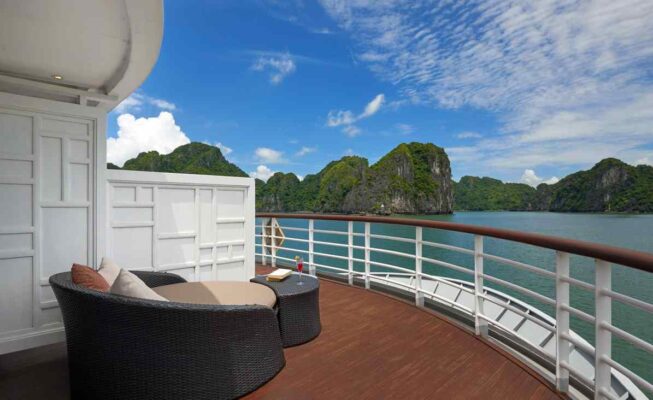
Understanding Seasonal Weather Patterns and Risks
Halong Bay’s climate varies dramatically throughout the year, directly impacting cruise safety:
Spring (February-April): Mild temperatures (59-73°F/15-23°C) with occasional fog reducing visibility to less than 100 meters in early morning hours.
Summer (May-August): Hot and humid with temperatures reaching 93°F/34°C. Typhoon season begins in June, with statistical peaks in August when 1-2 major storms may affect the bay.
Autumn (September-November): Ideal cruising weather with clear skies and temperatures between 70-82°F/21-28°C.
Winter (December-January): Cooler temperatures (55-68°F/13-20°C) with stronger winds averaging 15-20 knots from the northeast.
For maximum safety, consider booking your 3-day cruise experience during the optimal October-November window when weather conditions are most stable and visibility reaches up to 10km for spectacular views of the limestone formations.
Essential Items to Pack for Safety
Beyond typical vacation essentials, Halong Bay cruising demands specific safety-oriented items:
- Non-slip water shoes for wet decks and cave explorations
- Polarized sunglasses with UV400 protection
- Broad-spectrum sunscreen (minimum SPF 50)
- Insect repellent containing 20-30% DEET
- Motion sickness medication (even if you don’t normally need it)
- Waterproof phone case rated IPX8 or higher
- Personal first aid kit including antihistamines for potential marine stings
- Portable power bank (10,000mAh minimum) for communication emergencies
Onboard Safety Procedures
Mandatory Safety Briefings: What to Expect and Why They Matter
Upon boarding any reputable Halong Bay cruise, you’ll participate in a comprehensive safety orientation. Far from being a formality, these briefings provide life-saving information specific to your vessel.
The 2025-2027 updated safety protocols require all operators to cover:
- Vessel-specific evacuation routes with maximum evacuation time not exceeding 12 minutes
- Life jacket demonstration showing proper fastening techniques
- Assembly point locations marked with international safety symbols
- Emergency communication systems including alarm signals and PA announcements
- Fire safety equipment locations and basic operation instructions
- Man overboard procedures for both witnesses and crew response
Pay particular attention to how emergency signals differ from routine announcements—typically three long blasts indicate emergency evacuation, while intermittent short blasts signal man overboard situations.
Understanding Cabin Safety Features
Modern Halong Bay cruise cabins incorporate numerous safety elements that passengers should familiarize themselves with immediately after boarding:
- Emergency exit route maps posted on cabin doors
- Life jacket storage location (typically under beds or in wardrobes)
- Smoke detectors and sprinkler systems with indicator lights
- Emergency lighting that activates automatically during power failures
- Two-way communication devices connecting directly to the bridge
- Cabin door locking mechanisms that can be operated in darkness
On luxury vessels like those operated by Halong Bay Lux Cruises, cabins feature additional safety enhancements such as automated fire detection systems that can pinpoint smoke within 15 seconds and trigger compartmentalized responses.
Navigating Common Areas Safely
Public spaces on cruise vessels present unique safety considerations:
- Always use handrails when traversing stairs, especially during rougher conditions
- Identify all emergency exits from dining rooms, lounges, and sun decks
- Note the locations of emergency equipment including fire extinguishers (typically one every 25 meters) and first aid stations
- Respect capacity limitations in observation areas, which are calculated based on structural stress factors
- Follow marked pathways when moving between decks during evening hours
- Be aware of “wet zones” where slipping hazards increase after swimming activities
Water Activity Safety Guidelines
Swimming in Halong Bay: Permitted Areas and Precautions
Swimming in Halong Bay’s emerald waters ranks among travelers’ most anticipated activities, but should only occur under controlled conditions:
- Only swim in designated zones marked with floating boundaries
- Always wear the provided life vest regardless of swimming ability
- Follow the “buddy system” recommended by International Maritime Safety standards
- Observe posted water quality ratings updated daily (look for “Grade A” certification)
- Respect swimming time limits (typically restricted to 30-45 minutes)
- Avoid swimming after sunset when visibility and rescue capabilities diminish
The safest swimming experiences occur in the more secluded areas of Lan Ha Bay, where water clarity reaches 5-7 meters and currents remain minimal at less than 0.5 knots even during tidal changes.

Kayaking and Small Boat Excursion Protocols
Exploring limestone karsts via kayak or bamboo boat offers intimate connections with Halong Bay’s landscape, but requires adherence to strict safety measures:
- Mandatory life jacket wearing at all times without exception
- Stay within 500 meters of your cruise vessel or guide boat
- Carry waterproof emergency whistles (three blasts indicate distress)
- Follow designated routes marked on waterproof maps provided to each kayak
- Respect weather-based restrictions (kayaking is suspended when winds exceed 15 knots)
- Maintain visual contact with at least one other kayak in your group
- Return immediately when recall signals are given (typically one long horn blast)
Professional guides accompanying Halong Bay Lux Cruises excursions carry marine VHF radios with direct communication to the mothership, ensuring immediate response if conditions change unexpectedly.
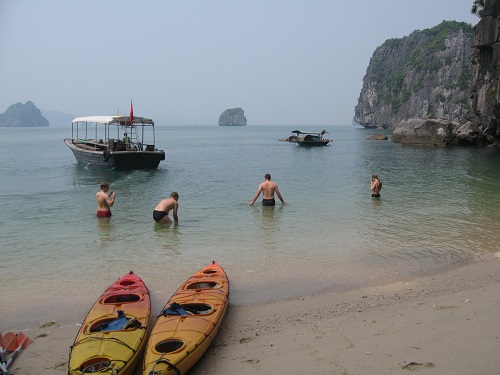
Cave Exploration Safety
Halong Bay’s limestone caves present unique hazards requiring special precautions:
- Wear appropriate footwear with non-slip soles—flip-flops are explicitly prohibited
- Stay on designated walkways which are professionally engineered with anti-slip surfaces
- Maintain three points of contact when navigating steeper sections
- Keep at least 2 meters distance from unprotected edges
- Never touch stalactites or stalagmites which may contain sharp edges
- Follow illuminated pathways and never use personal flashlights which can create disorienting shadows
- Listen for water drip patterns which indicate potential ceiling instability
The largest and most visitor-friendly cave, Sung Sot (Surprise Cave), features 750 meters of secured pathways with 214 non-slip steps and emergency evacuation routes that can clear the entire cave in under 20 minutes.
Health and Medical Safety
Managing Motion Sickness Effectively
Even those who rarely experience motion sickness may be affected in Halong Bay due to the unique combination of vessel movement and visual disorientation from the surrounding karsts.
Preventive strategies include:
- Taking over-the-counter medication (containing dimenhydrinate or meclizine) 30-60 minutes before departure
- Choosing a midship cabin where motion is minimized (70% less movement than bow or stern cabins)
- Maintaining focus on the horizon rather than looking at moving water
- Staying hydrated with at least 250ml of water every two hours
- Avoiding heavy meals before periods of increased boat movement
- Using pressure-point wristbands which may help some travelers
If symptoms develop, immediately inform crew members who can provide additional medication and arrange for cabin rest with proper ventilation.
Sun Protection Beyond the Basics
Halong Bay’s reflective waters intensify UV exposure by up to 35% compared to land locations at the same latitude. Comprehensive sun protection requires:
- Applying water-resistant sunscreen (minimum SPF 50) 30 minutes before sun exposure
- Reapplying every 80 minutes regardless of the product’s water-resistance claims
- Covering exposed skin with UPF-rated clothing (minimum UPF 30)
- Seeking shade between 10 AM and 3 PM when UV index typically exceeds 8
- Wearing polarized sunglasses that block 100% of UVA and UVB rays
- Using broad-brimmed hats providing at least 4 inches of shade to face and neck
Severe sunburn is the most common medical issue reported on cruises, affecting approximately 22% of passengers who inadequately protect themselves.
Emergency Medical Services and Facilities
While most cruises proceed without incident, understanding available medical resources ensures preparedness:
- All licensed cruise vessels maintain medical kits exceeding Vietnam Maritime Administration requirements
- Crew members certified in first aid (minimum 3 per vessel under 2025 regulations)
- Automated External Defibrillators (AEDs) positioned for access within 3 minutes from any point on the vessel
- Oxygen therapy equipment for respiratory emergencies
- Direct communication lines to shore-based medical services
For serious emergencies, Halong Bay has implemented a rapid response system:
- Emergency speedboats stationed throughout the bay can reach any vessel within 15-25 minutes
- Helicopter evacuation available from designated landing points with transport to Quang Ninh General Hospital (Level 1 Trauma Center)
- International SOS coordination for travelers requiring specialized care
When booking extended itineraries that combine Halong Bay with Ninh Binh, travelers gain access to additional emergency facilities along the route, creating a comprehensive safety network throughout the journey.
Environmental Hazards and Wildlife Safety
Understanding Marine Life Encounters
Halong Bay’s ecosystem hosts diverse marine life, most harmless but requiring respectful distance:
- Jellyfish populations peak during August-September with increased sightings of moon jellies (non-dangerous) and occasionally box jellies (potentially dangerous)
- Coral formations in shallow areas can cause cuts if contacted
- Various fish species including lionfish in deeper sections that should never be touched
- Sea urchins on rocky bottoms requiring careful foot placement
Cruise operators monitor marine life patterns daily, restricting swimming in areas with increased jellyfish activity. The latest 2025 protocols require all vessels to carry vinegar solution (5% acetic acid) for treatment of potential stings.
Weather-Related Safety Procedures
Halong Bay’s weather can change rapidly, triggering standardized safety responses:
- Thunderstorm protocols activate when lightning is detected within 10km, requiring all passengers to move indoors
- High wind procedures begin at 25 knots, restricting deck access and securing loose items
- Fog navigation systems engage when visibility drops below 1km, utilizing radar and reduced speeds
- Typhoon contingency plans may require return to port when Category 1 or higher systems approach within 200km
In 2025, the Vietnamese government implemented an advanced weather monitoring system with 12 stations throughout Halong Bay, providing real-time data to all cruise operators and triggering automated alerts when conditions deteriorate.
Communication and Emergency Response
Understanding Emergency Signals and Procedures
International maritime standards govern emergency communications in Halong Bay:
- Seven short horn blasts followed by one long blast signals emergency assembly
- Verbal announcements in multiple languages including English, Vietnamese, Chinese, Korean, and Japanese
- Visual signals including red flares visible for 11km and orange smoke signals
- Emergency lighting systems activated automatically during power failures
When an emergency signal sounds, passengers should:
- Grab life jackets from their designated storage locations
- Proceed calmly to assembly points following illuminated pathways
- Follow crew instructions without deviation
- Assist fellow passengers with mobility limitations
- Remain at assembly points until formal “all clear” is given
Maintaining Contact with Shore Services
Modern cruises maintain continuous communication with land-based services:
- Satellite phones with dedicated emergency channels
- Marine VHF radio systems monitored 24/7 by Halong Bay Maritime Control
- Cellular network coverage reaches approximately 87% of cruising areas as of 2025
- AIS (Automatic Identification System) tracking vessel locations in real-time
Passengers should store important contacts in their phones:
- Vietnam Tourist Emergency Line: 1800 6838 (toll-free)
- Halong Bay Marine Police: +84 33 3846 941
- International SOS Vietnam: +84 28 3829 8520
Cultural Safety and Responsible Tourism
Respecting Local Communities During Floating Village Visits
Halong Bay’s floating communities welcome visitors but have established guidelines to ensure safety and cultural respect:
- Follow designated walking paths on floating platforms
- Maintain group sizes under 15 people on any single structure
- Respect weight limitations on smaller floating homes (typically 1000kg maximum)
- Ask permission before taking photographs of residents
- Avoid touching or moving personal belongings
- Maintain appropriate dress standards including covered shoulders
The Cua Van floating village, with its 132 households, has established visitor management systems that limit daily visitors to 300 and enforce 45-minute maximum stays per group to prevent overcrowding on sensitive floating structures.
Environmental Protection Responsibilities
Travelers play a crucial role in preserving Halong Bay’s UNESCO World Heritage status:
- Never dispose of any waste in the water
- Report observed pollution to cruise management immediately
- Avoid touching or collecting marine life including shells and coral fragments
- Use only biodegradable sunscreen to prevent chemical damage to marine ecosystems
- Minimize water usage onboard to reduce greywater production
- Participate in organized clean-up activities offered by eco-conscious operators
Premium operators like Halong Bay Lux Cruises have implemented comprehensive waste management systems that process and properly dispose of all cruise-generated waste, achieving zero discharge into the bay waters.
Technology-Enhanced Safety Measures for 2025-2027
Digital Safety Innovations
The latest cruise vessels incorporate advanced technologies enhancing passenger safety:
- Real-time location tracking bracelets issued to each passenger
- AI-powered monitoring systems detecting unusual movement patterns indicating potential falls
- Thermal imaging cameras identifying fire risks before visible flames appear
- Water quality sensors continuously testing swimming areas for contaminants
- Automated weather integration systems adjusting itineraries based on forecasting algorithms
These technologies operate seamlessly in the background, requiring no passenger interaction while providing comprehensive safety coverage throughout the journey.
Mobile Applications for Emergency Communication
Most premium operators now offer dedicated safety apps providing:
- One-touch emergency alerts to cruise staff
- GPS-enabled location sharing
- Offline access to safety information
- Real-time weather alerts specific to your vessel’s location
- Medical emergency templates translating symptoms into Vietnamese
Download these applications before your journey and test functionality while still connected to reliable internet.
Final Halong Bay Safety Tips Checklist Before Departure
Before embarking on your Halong Bay adventure, complete this essential safety verification:
- ✓ Confirm your cruise operator’s safety certifications
- ✓ Review current weather forecasts for your specific travel dates
- ✓ Pack all recommended safety items
- ✓ Inform someone at home about your detailed itinerary
- ✓ Purchase comprehensive travel insurance covering marine activities
- ✓ Download relevant safety applications
- ✓ Store emergency contacts in an easily accessible location
- ✓ Bring necessary medications in original packaging with extra supply
With these preparations complete, you’re ready to experience the breathtaking beauty of Halong Bay with confidence and peace of mind. The limestone karsts, emerald waters, and floating villages await—all to be enjoyed with the assurance that comes from thorough safety awareness.
For more information on creating the perfect balance of adventure and security, explore the 2-day Halong Bay luxury cruise options that provide comprehensive safety systems alongside unforgettable experiences.
This Halong Bay Safety Tips is regularly updated with the latest regulations and best practices. Last revised: January 2025.
- Hotline | WhatsApp: +84.978.358.422
- Phone | WhatsApp: +84.962.261.687
- Email: halongbayluxcruises@gmail.com
- vietnammarveltravel@gmail.com



